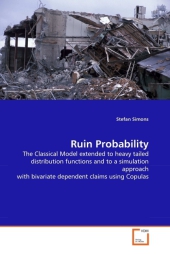 Neuerscheinungen 2011Stand: 2020-01-07 |
Schnellsuche
ISBN/Stichwort/Autor
|
Herderstraße 10
10625 Berlin
Tel.: 030 315 714 16
Fax 030 315 714 14
info@buchspektrum.de |

Stefan Simons
Ruin Probability
The Classical Model extended to heavy tailed distribution functions and to a simulation approach with bivariate dependent claims using Copulas
2011. 128 S. 220 mm
Verlag/Jahr: VDM VERLAG DR. MÜLLER 2011
ISBN: 3-639-31986-9 (3639319869)
Neue ISBN: 978-3-639-31986-6 (9783639319866)
Preis und Lieferzeit: Bitte klicken
Ruin probability is a central component of actuarial science. The first part of this thesis describes the classical model including some premium principles and derives some main results, such as the Upper Lundberg bound and the Cramér-Lundberg approximation formula. One assumption for these results is the existence of the adjustment coefficient. Heavy tailed distribution functions are treated in the second part, where it is shown that this coefficient does not exist. Then some results from the classical model are extended to a class of heavy tailed distribution functions, i.e. subexponential functions. A central limit theorem for stable distribution functions is shown. Regularly and slowly varying functions as well as mean excess functions are explained. The third part describes some dependency structures, with a focus on copula functions, and explains the simulation procedure. First, the classical model is simulated using three different distribution functions: a light tailed, a medium tailed and a heavy tailed function. Following this, bivariate dependent claims are assumed, which are modeled with different copula functions: with and without tail dependency.
Stefan Simons was born in Heidelberg in 1978. After a banking apprenticeship, he studied Mathematical Finance at the University of Constance. During his studies, he gained practical experience in the reinsurance industry. Following this, he started his professional career as an insurance mathematician with Munich RE.


